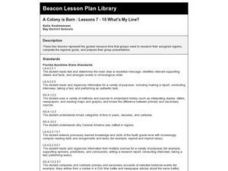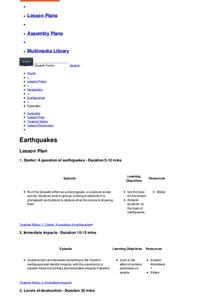Curated OER
How Historians Know: Investigating a Midwife's Life
Students view "A Midwife's Tale" to explain the methods historians use to study the past. They complete worksheets to identify what historians look for.
Curated OER
War Story Documentary
Students research and create an aspect of a war. They practice on writing a bibliography and essays.
Curated OER
Past and Present
High schoolers research their community history and choose on aspect to create an iMovie on. They use digital photographs and old images of community place that show how they have changed.
Curated OER
Theobroma - Food of the Gods
Students discuss the history of cacao and its use in the production of chocolate. They analyze actual cacao pods and record their observations. Finally they create a five minute contour drawing of the cacao pod and seeds.
Curated OER
The Causes of Prohibition
Eleventh graders explore the origins of the Prohibition Movement in the United States. In small groups, they analyze the influence of World War I in the passage of the eighteenth amendment. Students explain how different demographics of...
Curated OER
Creation of An Educational Toy, Game, or Story
Seventh graders create a toy, game or story suitable for a young child. They research magazines, catalogs, and child development texts for ideas. Students consider the age and development of the child.
Curated OER
Mothers' Milk-Unleaded, Please
Lead toxicity is a hot topic these days, especially when it was a common component in household paint for many years. In Taiwan, there was concern that babies were being exposed to toxic levels of lead through breast milk. A study was...
Curated OER
P.E. Lesson: Black Bear
Students run and try to tag a classmate as "Black Bear, Black Bear" is yelled by another student. In this P.E. activity, students try to get to the opposite side of a playing area without being tagged or being tricked by the person who...
Virginia Department of Education
Synthesizing to Support a Thesis- Big Picture Emphasis
Help your researchers as they begin to develop a topic for research with these worksheets. Included are two nicely designed graphic organizers that assist students in narrowing and researching their topic, and an efficient...
Curated OER
The Industrial Age in America: Robber Barons and Captains of Industry
Middle schoolers define terms "robber baron" and "captain of industry," list positive and negative actions of one or more captains of industry/robber barons, and take and support stand as to whether particular financier/industrialist is...
Denver Art Museum
Putting Images into Words
Engage your class in art analysis of Indian Look-Alike by Melanie Yazzie. Using this work of art as inspiration, writers compose a poem or short story. After a peer review session, the teacher conveys information about the work of art as...
Curated OER
Color
Students color in one of Keith Haring's design 3 different ways to compare how color effects a drawing. In this color lesson plan, students display their paintings and compare them as a class.
Curated OER
Data Management and Probability: Applications
In this data management and probability applications worksheet, 8th graders solve 20 various types of probability problems. They find the mean, median, mode and range of various numbers. Then, students use the spinner illustration to...
Curated OER
Mixing Colors with "Little Blue and Little Yellow"
Students mix colors to make new colors. In this color mixing lesson, students listen to Leo Lionni's Petit Bleu et Petit Jaune, before retelling the beginning, middle, and end of the story. They watch as the teacher mixes food coloring...
Curated OER
Education in Colonial New England
Fifth graders examine schooling now and in New England Colonies. In this compare and contrast lesson, 5th graders describe schools of the present to schools of the past. Students also investigate the goals of schooling and the part...
Curated OER
The Middle Passage
Eighth graders locate the Middle passage and describe the experiences of slaves in the Middle Passage. In this Middle Passage lesson, 8th graders describe life as a slave during the Middle Passage. Students write as if they...
Curated OER
A Colony is Born : Lesson 6 -To Leave or Not to Leave
Fifth graders connect reasons for coming to the New World with identity. The create identities and place them in one of three settled regions. They refer to prior study notes in their Colonial Notebooks to establish their identities.
Curated OER
A Colony is Born : Lessons 7 - 10 What's My Line?
Fifth graders research their assigned regions, complete regional guide and prepare presentations about the New World colonists. They refer to "Everyday LIfe: Colonial Times" as well as searching marked internet sites.
Curated OER
Allelopathy Experiments
Learners explore how allelopathy works in plants. In this botany lesson, students explain how this phenomenon affect other organisms. They read and analyze an article about allelopathy and discuss its flaws.
Curated OER
A Christmas Celebration in the Black Culture
How much does your class know about Kwanzaa? Using the Internet, pupils practice using the Internet to find information. They then compare and contrast the similarities and differences between Kwanzaa and Christmas.
Curated OER
Black And Asian Involvement in World War 2
High schoolers read story excerpts from the BBC WW2 People's War archive to discover the contributions and obstacles faced by Asian and Black participants in World War 2 British forces. They prepare a radio report describing the...
Curated OER
Faith in Wartime
Young scholars explore World War II and the people of that era. Numerous activities allow students to examine conscientious objectors; why it was difficult for people to maintain their religious faith while experiencing the horrors of...
Curated OER
Earthquakes
Students take a closer look at earthquakes. In this earthquake lesson, students investigate the causes of Kashmir earthquake and the impact of the earthquake. Students also consider aid efforts in the aftermath of earthquakes.
Curated OER
At Play
Ninth graders evaluate works of Robert Harris. They apply historical methodology to interpret and understand time, continuity, and change at an age appropriate level. They demonstrate awareness of the effect of context.























